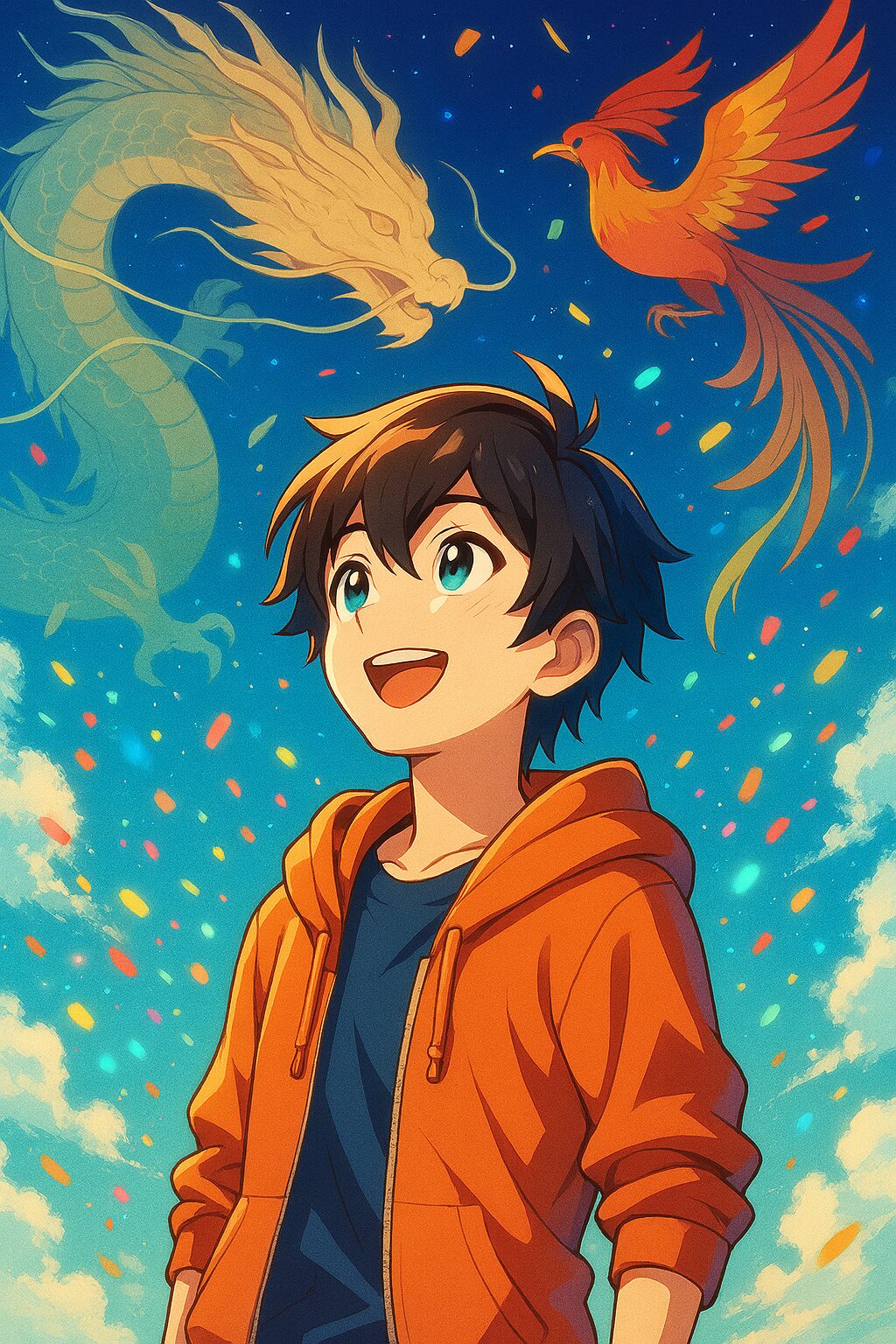Japan exports a wide array of unique cultures to the world, but the one that shines the brightest, crossing all borders and commanding a passionate global following, is “Anime.” And every year on October 22nd, we celebrate this magnificent culture as “Anime Day.”
To understand why this day is celebrated on October 22nd, we must delve into its history: on this very date in 1958, Japan’s first feature-length color animated film, Hakujaden (The Legend of the White Snake), was released. Produced by Toei Doga (now Toei Animation), this work transcended the boundaries of short films and black-and-white animation, profoundly influencing the subsequent development of Japan’s animation industry. Notably, numerous anime creators, including Director Hayao Miyazaki, were inspired by this film, which became a catalyst for their entry into the world of animation.
The year 1958, when Hakujaden premiered, was a time of hope in Japan, transitioning from the post-war recovery period to an era of rapid economic growth. Amidst technological advancement and a growing demand for popular culture, this full-color feature film provided precisely the “dreams” and “color” that the people of the time were seeking. Approximately 60 years later, in 2017, to commemorate the “100th Anniversary of Japanese Animation,” this historic date was officially designated as “Anime Day.” This is not merely a celebration of the past but a powerful declaration of intent to project the future of Japanese anime to the world.
Anime: The Essence of Japanese Culture – A Fusion of Tradition and Innovation
A deeper look into Anime Day reveals a profound connection between the core of Japanese culture and anime itself. Japanese animation is more than just entertainment; it is a contemporary art form that condenses Japan’s “storytelling culture,” “tradition of visual expression,” and “philosophical thought.”
1. The Legacy of the Choju-giga Carried from Manga
Japanese anime often originates from manga (Japanese comics). The roots of manga can be traced back to the National Treasure Choju-jinbutsu-giga (Scrolls of Frolicking Animals and People), believed to have been drawn from the late Heian to early Kamakura periods. This scroll, which personifies animals to depict human society humorously and satirically, is considered the origin of Japan’s “dynamic line work” and the “power to convey emotion through simple expressions.” Anime takes this traditional visual culture and merges it with the latest digital technology, elevating it into a world-class form of expression.
2. Expressing Mono no Aware and the View of Nature
A key element of Japanese culture is Mono no Aware, an aesthetic sensitivity to the ephemeral nature of things and a gentle melancholy towards their passing. In many anime works, particularly those from Studio Ghibli, the changing of seasons, the fragility of life, and the harmony or conflict between humans and nature are depicted with extreme delicacy. This is deeply intertwined with Japan’s “nature worship” and “Shinto worldview,” which posits that myriads of gods dwell in all things. Thus, anime conveys the fundamental emotions and philosophy of the Japanese people, not just mere fantasy.
3. Bushido and Communal Ethics
The “coming-of-age story,” where a protagonist overcomes challenges, is an anime staple. Underlying this is a strong reflection of Japanese ethics, such as the “spirit of self-sacrifice,” “bonds with comrades,” and “the role of the individual within a group,” exemplified by the philosophy of Bushido (the way of the warrior). This contrasts with the individualistic hero archetypes often seen overseas and serves as a vital key for many foreign viewers to understand Japanese social structures and values.
By incorporating these traditional elements into diverse genres like sci-fi, fantasy, romance, and slice-of-life, and developing them into modern, universal themes, anime resonates with people across the globe.
Reflecting on Anime Day: Which Film Changed Your Life?
As we celebrate Anime Day on October 22nd, we must deeply reflect on the power of this culture.
Japanese anime does more than just provide entertainment; it sometimes serves as a life guide, a window to different cultures, and an opportunity to encounter new values. For some, it might spark an interest in Japanese history or mythology; for others, it might be a chance to reaffirm universal themes like friendship and perseverance.
What impact has Japanese anime had on you?
- Did you strongly empathize with a character’s way of life and change your approach to work or study?
- Did anime introduce you to Japanese food or landscapes, making you strongly desire to visit Japan?
- Did you have deep conversations with friends or family about the philosophical messages embedded in a work?
If you are a creator yourself, this “Anime Day” is a wonderful opportunity to try creating a new story themed around Japanese tradition or modern challenges. What message do you want to convey to the world using the powerful medium of animation?
Anime is a culture that is constantly evolving. Let us celebrate the past, enjoy the present, and look forward with great anticipation to what future works will bring us.
【References and Related Links】
Internal Links (Related Categories within this Blog)
External Links (Official and Reliable Sources)
- The Association of Japanese Animations (AJA) – The organization that established “Anime Day.” A source for information on Japan’s animation industry.
- Toei Animation Co., Ltd. – Current information from the studio that produced Hakujaden.
10月22日:世界を魅了する「アニメの日」― 日本文化の深層を読み解く
日本は世界に対して数多くの独自の文化を発信していますが、その中でも特に強烈な光を放ち、国境を越えて熱狂的なファンを持つのが「アニメ」です。そして、毎年10月22日は、この偉大な文化を讃える「アニメの日」として制定されています。
この記念日がなぜ10月22日なのか、その歴史を紐解くと、1958年のこの日に日本初のカラー長編アニメーション映画『白蛇伝(はくじゃでん)』が公開されたという、極めて象徴的な出来事に行き当たります。東映動画(現在の東映アニメーション)が制作したこの作品は、それまでの短編アニメやモノクロ作品の枠を超え、後の日本のアニメーション産業の発展に計り知れない影響を与えました。特に、宮崎駿監督をはじめとする数々のアニメクリエイターたちが、この作品に触発され、アニメーションの世界に進むきっかけになったと言われています。
『白蛇伝』が公開された1958年は、戦後の復興期から高度経済成長期へと移行する日本の希望に満ちた時代です。技術の進歩と大衆文化への欲求が高まる中、このフルカラーの長編作品は、まさに当時の人々が求めていた「夢」と「色彩」を提供しました。その公開から約60年後の2017年、「日本のアニメーション100周年」を記念し、この歴史的な日を「アニメの日」として正式に制定。これは、単なる過去の称賛ではなく、日本アニメの未来を世界に向けて力強く発信する意志の表明に他なりません。
日本文化の粋を映すアニメ:伝統と革新の融合
アニメの日を深く読み解くと、そこには日本文化の根幹とアニメとの密接な関連性が見えてきます。日本のアニメーションは、単なるエンターテイメントの域を超え、日本の「物語を語る文化」「視覚表現の伝統」「哲学的な思考」が凝縮された現代の芸術形式なのです。
1. 漫画から受け継がれた「鳥獣戯画」の伝統
日本のアニメは、しばしば漫画(MANGA)を原作としています。この漫画のルーツは、平安時代末期から鎌倉時代初期に描かれたとされる国宝『鳥獣人物戯画(ちょうじゅうじんぶつぎが)』にまで遡ることができます。この絵巻物は、動物を擬人化し、ユーモラスかつ風刺的に人間社会を描いたもので、日本の「動きのある線」や「簡潔な表現で感情を伝える力」の原点とされています。アニメは、この伝統的な視覚文化を最新のデジタル技術と融合させ、世界に通用する表現へと昇華させました。
2. 「もののあわれ」と「自然観」の表現
日本文化の重要な要素に、移ろいゆくものへの哀愁や美意識を示す「もののあわれ」があります。多くのアニメ作品、特にスタジオジブリ作品などに顕著ですが、季節の移ろい、儚い命、そして人間と自然との調和や対立が、極めて繊細に描かれます。これは、八百万の神々が宿ると考える日本の「自然崇拝」や「神道的な世界観」と深く結びついており、単なるファンタジーとしてではなく、日本人の根源的な感情や哲学を伝えています。
3. 「武士道」や「集団の倫理観」
主人公が困難に立ち向かう「成長物語」はアニメの定番ですが、その背景には、武士道に代表される日本の「自己犠牲の精神」「仲間との絆」「集団の中での個の役割」といった倫理観が色濃く反映されています。これは、海外の個人主義的なヒーロー像とは一線を画し、多くの海外の視聴者にとって、日本の社会構造や価値観を理解する手がかりともなっています。
アニメは、これらの伝統的な要素を、SF、ファンタジー、恋愛、日常系といった多様なジャンルに取り込み、現代的かつ普遍的なテーマへと展開させることで、世界中の人々の共感を呼んでいます。
アニメの日に考える:あなたの人生を変えた一本は?
10月22日、アニメの日を迎えるにあたり、私たちは改めて、この文化の力について深く考えてみるべきです。
日本のアニメは、単に娯楽を提供するだけでなく、時に人生の指針となり、異文化への窓口となり、新しい価値観との出会いを提供します。ある人にとっては、日本の歴史や神話への興味を持つきっかけとなり、またある人にとっては、友情や努力といった普遍的なテーマを再認識する機会となるでしょう。
あなたはこれまでに、日本のアニメからどのような影響を受けましたか?
- ある作品のキャラクターの生き方に強く共感し、自分の仕事や学業への取り組み方を変えましたか?
- アニメを通じて日本の食文化や風景を知り、実際に日本を訪れたいと強く思いましたか?
- 作品に込められた哲学的なメッセージについて、友人や家族と深く語り合いましたか?
もし、あなた自身がクリエイターであれば、この「アニメの日」を機に、日本の伝統や現代の課題をテーマにした新しい物語を創造してみるのも素晴らしい試みです。アニメーションという強力な表現手段を使って、世界に何を伝えたいですか?
アニメは常に進化し続ける文化です。過去を称え、現在を楽しみ、そして未来の作品が私たちに何をもたらしてくれるのか、期待に胸を膨らませて待ちましょう。
【参考・関連リンク】
内部リンク(このブログ内の関連カテゴリー)
外部リンク(公的機関・信頼できる情報源)
- 一般社団法人 日本動画協会(AJA) – 「アニメの日」を制定した団体。日本の動画産業に関する情報源。
- 東映アニメーション株式会社 – 『白蛇伝』を制作したスタジオの現在の情報。



コメント